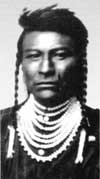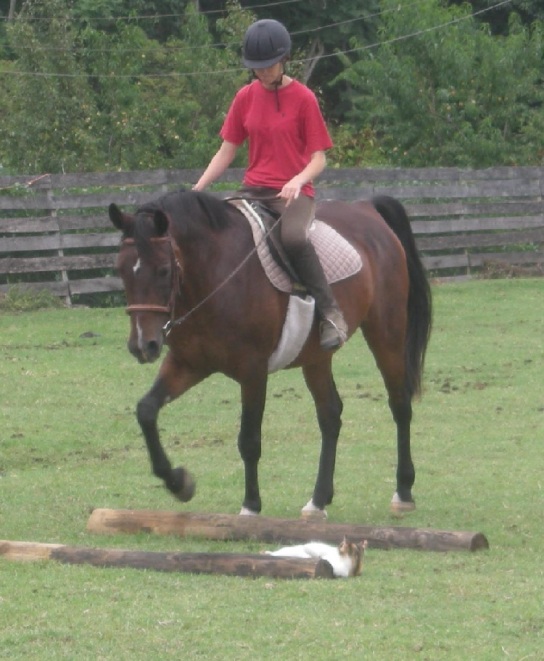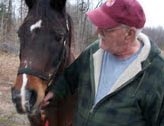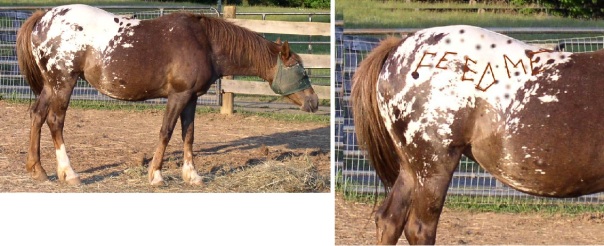March Featured Horse Rescue
We’re excited to announce that HN has partnered with SnarkyRider.com to feature one horse rescue each month as well as an adoptable horse each week. Our first featured rescue is White Bird Appaloosa Horse Rescue.
From SnarkyRider.com, an interview with the Virginia-based White Bird Appaloosa Horse Rescue:
Where did the name of your rescue come from? What’s the story behind it?
When we began our rescue in 2002, we decided that we wanted to specialize in Appaloosas because this is a breed we know and love. So, we looked for a name that reflected their Nez Perce heritage. We had it narrowed down to two candidates: “Looking Glass” and “White Bird.” Both of these are the names of famous Nez Perce Chiefs.
I had some concerns about naming a horse rescue “Looking Glass Rescue,” thinking that it would create a Mecca for 10-year old girls who wanted to talk about unicorns. So we considered White Bird, who was one of the Nez Perce Chiefs involved in the Battle of Bear Paw during the 1877 Nez Perce War. The most famous of these Chiefs was the peace-loving Chief Joseph, who is best remembered for his dignified surrender, “I will fight no more forever.”
Chief White Bird, however, didn’t trust the promises of the Cavalry and refused to surrender. He was able to escape to Canada with members of his band and about 300 horses, preserving some of the Appaloosa lineages for posterity. But White Bird was a bit of a scoundrel, too, and alternate versions of the story imply that he had something to do with starting the war to begin with. This more rebellious personality appealed to us (especially since it turned out that he was largely correct) and the rescue became White Bird.
Are you strictly Appaloosas? Why?
We specialize in Appaloosas, but we won’t turn away horses of other breeds if the need is urgent and we have the resources to help. Recognizing that we couldn’t save everyone, we were determined to be efficient in helping those we could. Specializing in Appaloosas not only allowed us to provide a point of contact between horses needing homes and the people looking for them, it enabled us to become proficient in spotting and treating the disorders they are prone to, such as squamous cell cancers, sarcoids and vision issues. But we still care a lot more about whether a horse is really in trouble than whether he has spots. A bottle of “Wite Out” can add spots pretty quickly
What’s your best/happiest rescue success story?
Gosh, that’s a tough one! But I’m going to focus on one that’s pretty recent. We were asked to take in a horse seized by Animal Control in a neighboring county. Blitz was one of a handful of horses that had been starved. He was scored a Body Condition 1 by the attending vet.
After several months, he had regained his weight and condition. We did a training tune-up and he was ready for a new home.
Meanwhile in a nearby county, a returning rider had waited until retirement to buy his horse and just built a beautiful new barn. For unknown reasons, the horse he bought colicked within a week, and he was referred to us.
One of our adoption criteria is to make sure that a horse and rider are well suited to each other’s skill levels, disciplines and personalities. When Glen came out to meet Blitz, he watched our rider demonstrate what the horse knew. He was ready to adopt him on the spot. But we explained that we had to make sure of the match and asked that he ride the horse.
The soft-spoken sexagenarian considered the request for a moment, hesitated and explained that he was a little rusty. Then, with some reluctance, he agreed to ride him. We held our collective breath as he mounted the horse. He then asked if we required that he use the stirrups. Within seconds, we realized his ability. This was a returning rodeo rider, with a wonderful seat and gentle hands. We had a good laugh over that one. It was, indeed, a match made in Heaven and they have lived happily ever after.
Do you think Appaloosa’s are better at Hide and Go Seek because of their ‘camouflage’ (spots)?
We believe that Appaloosas use their coat patterns in a more gestalt fashion. In other words, the individual spots, when viewed at certain angles or distances, come together in a meaningful way, due to the mind’s tendency to create relationships where none apparently exist, in other words, the “whole is different from the sum of its parts.” Appys know this and their ability to convey subliminal messages to each other and to us is unparalleled in the animal kingdom. The first photographs of these horses show an apparently random coat pattern. However, when viewed in the right perspective and at the right focal length, the meaning of the pattern becomes clear.
What advice/tips would you give to future Appaloosa adopters and owners?
Please monitor their eyes and their vision. Appaloosas are especially prone to a disorder called Equine Recurrent Uveitis (ERU). It is so common that we routinely check horses’ eyes as they are walking in the door. Uveitis is an immune mediated disorder that causes repeat inflammation of an area of the eye called the uvea. It is thought to have a number of environmental triggers, including allergies, stress, sun and dust. But the result is the same. Over time, the repeat cycles of inflammation will destroy their vision. And uveitis hurts. Horses having flare ups will often tear, squint or clench their eyes.
If you are an Appaloosa owner and your horse is doing any of these things, please contact your vet. There are measures you can take to slow down the progress of this disorder and failing to do so will eventually blind your horse. As it is the inflammation itself that does all the damage, this is where efforts need to be targeted. We keep our guys on a regimen of daily aspirin powder and/or MSM to reduce inflammation. If their eyes flare up anyway, we apply steroid ointment (it’s important to be absolutely sure of the cause, as steroids will further irritate eyes that have injuries or abrasions). Atropine and dexamethasone are also pharmaceutical guns that can be used against severe flare ups. All will help to prolong your horse’s vision and your veterinarian is your best source of specific recommendations. There is new method of treatment that is under investigation that consists of permanently inserting cyclosporine discs into the eye. It has shown very good results with some horses.
I’d also like to to talk a little about blindness. If you are the owner of a blind horse, hats off to you for recognizing that you are now more important than ever in his or her life. But you many not realize that the disorder that blinded him has not departed along with his vision. He is probably still uncomfortable. So it’s important to continue to treat his condition even after he has lost his sight.
What your guy or gal doesn’t need is to be surrendered to a rescue or given away. I can’t tell you how many of these calls we get. Unless there is an immediate safety problem, blind horses that are adjusted to their companions and surroundings should stay right where they are. You are not doing them any favors by putting them through the process of adjusting to new surroundings and establishing a new pecking order. They can get stressed and bullied and even if they are sent to a rescue, they are not likely to be adopted. Blind horses need little additional care or attention and should remain with their owners. After all, if you care about them and you are still willing to send them away, you can be guaranteed that others will value them even less. By the time we get them, they have often really suffered. Please do the right thing and keep them home.
Presented by SnarkyRider.com:














Leave a Comment